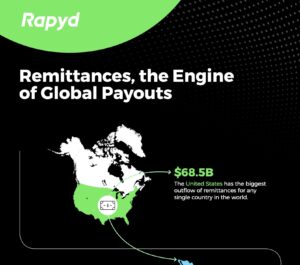Sending Remittances Overseas Looks Very Different Today than It Did a Few Months Ago
Table of Contents
As COVID-19 restrictions persist around the world, international remittance companies have had to adjust. For years many people have relied on using cash to fund remittances and pick-ups at the receiving end. Many stores that support this model have been forced to limit customer engagement or simply close their doors altogether. This sudden shift in global remittance has companies and individuals scrambling to adopt digital payout solutions to transfer money across the globe.
2019 was a record year for remittances – at 714 Billion USD – it was the highest remittance volume ever recorded.1 The top three countries receiving remittances were India, China, and Mexico – most of the money transfers represented migrant workers sending remittances back home.
Download the Rapyd Remittance Infographic to see Where the Money Flowed in 2019
This year, amidst the pandemic and economic downturn, remittances are projected to decline by 20%.2 This drop is mostly attributed to migrant workers no longer sending home funds as they struggle to find work overseas. As a result of the pandemic, the global economy is further projected to contract by 3% in 2020, even more than during the ‘08–’09 financial crisis.3
Three Ways Remittance Companies Can Embrace Digital Disbursement Method
Many international money transfer agencies are struggling to adapt to a model where people can’t pick-up and make remittances in person. Money transfer organizations are seeking digital payout solutions that work for the workers, families and loved ones receiving remittances.
Solutions include:
- Wire transfers or bank transfers: Utilizing local bank transfers (such as ACH in the US) works well for workers and recipients that have bank accounts. Bank transfers are the most popular transfer method across Asia.4 But many of the countries receiving higher volumes of remittances have large unbanked populations.
- eWallet options: Several international money wallets allow money transfers without a bank account. Funds can be received, held and sent from a digital wallet. Similar to Alipay or WeChat pay in China but without the dependency of a bank account.
- Prepaid cards: Push to Card payouts via Mastercard Send or Visa Direct give recipients quick access to funds, does not require a bank account and typically has lower fees.
An Innovative Approach to Sending and Receiving Funds is Key
As smartphones become ubiquitous – over 3 billion people already have a smartphone today5 – and social distancing continues, a shift to digital remittances is an effective approach. Innovative product leaders inside remittance companies will look at developing their own ewallets and pre-paid card products to drive customer loyalty. They can fast-track this process by embracing existing white-label solutions.
Ready to Integrate Digital Disbursements into Your Global Remittance Services?
Rapyd’s API and SDKs make it easy to quickly integrate global payout methods such as ewallets, bank transfers and cards. Learn more at https://www.rapyd.net/solutions/remittances/
Sources:
- https://economictimes.indiatimes.com/news/economy/finance/remittances-to-south-asia-to-dip-22-in-2020-wb/articleshow/75305762.cms
- https://www.worldbank.org/en/topic/migrationremittancesdiasporaissues/brief/migration-remittances-data
- https://www.imf.org/en/Publications/WEO/Issues/2020/04/14/weo-april-2020
- Rapyd 2020 APAC Consumer Online Buying and Payment Study
- https://www.statista.com/statistics/330695/number-of-smartphone-users-worldwide/
Subscribe Via Email
Thank You!
You’ve Been Subscribed.




